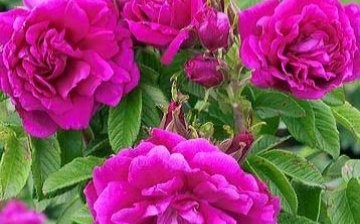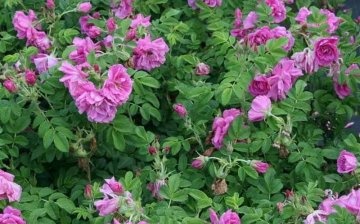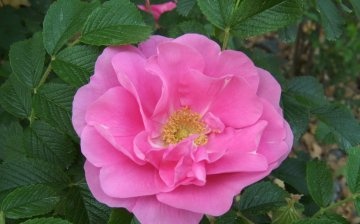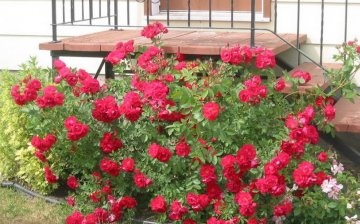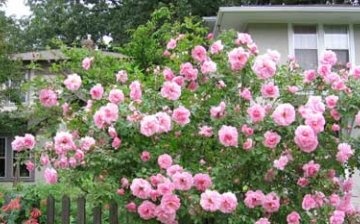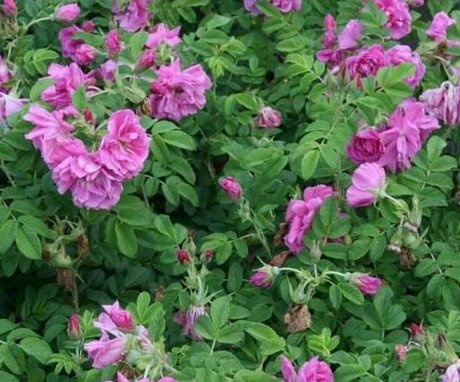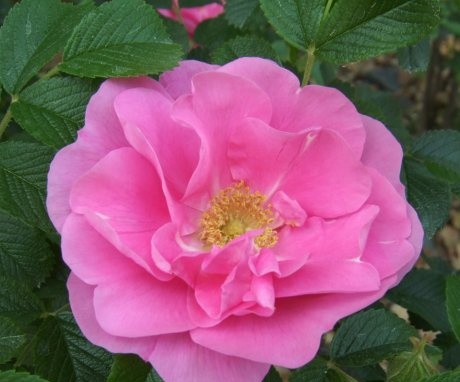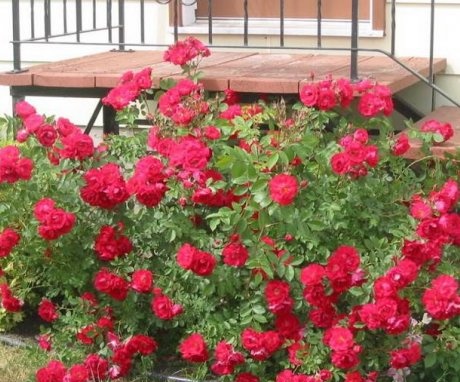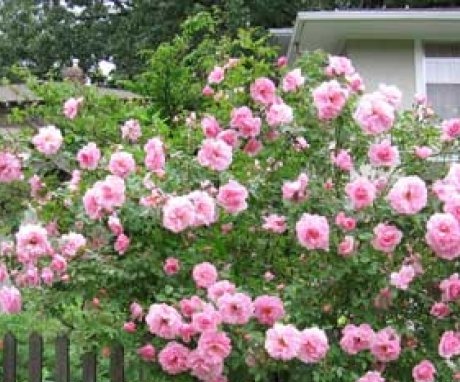Rose rugosa and its types, care and features
Rose rugosa is a rather attractive plant that is grown on the edges, in single plantings, etc. This plant is capable not only of decorating landscape design, but also not demanding in care.
Content:
Description of Rugosa rose
Rugosa rose can serve as a decorative hedge. This plant has rather thick woody shoots that do not need pruning. The rose is thickly covered small and large thorns.
They are characterized by acicular and crescent shape. The foliage of this bush is characterized by a bright green color with a characteristic shine. The constellation leaves include seven leaves, which have a rounded-elliptical shape and a jagged edge. The lower part of the leaflets is characterized by the presence of abundant gray-tomentose pubescence.
Rugosa rose flowers, depending on the species, can be either single or collected in inflorescences.
The color of flowers can be varied (white, yellow, pale pink, bright red, etc.). This plant begins to bloom in late May or early June. During this period, the rose blooms most profusely. Further, the number of flowers is significantly reduced, but flowering continues until the first frost.
After this plant stops blooming, fruits appear at the place of flowering.
During ripening, they take on an orange-red color. This plant is characterized by a sufficiently powerful root system that can easily kill weaker neighbors. That is why the rose must be planted as an independent plant.
Plant species
Rose rugosa has a large number of types, which differ from wild rose by a high level of decorativeness. Most of all, these plants are attracted by the pleasant aroma of large and double flowers. Absolutely all types of roses are characterized by a high level of winter hardiness. The fruits of this plant are not only beautiful, but also very useful, which makes it possible to use them in traditional medicine.
The most popular among these plants are the Dutch rose varieties, the Cordosa varieties, the Teresa Bunier variety.
Canadian rose varieties are characterized by:
- The presence of large flowers that have a pink color of various shades.
- The flowers of this plant differ from their counterparts in a pleasant aroma.
- They are also characterized by a cup-shaped shape. The petals of these rose varieties are characterized by a serrated edge.
- These roses were first bred in Holland by crossing the polyanthus rose and the rugosa rose.
- This plant is able to bloom throughout the summer period without interruption, which significantly increases their value.
The Teresa Bunier variety is characterized by decorativeness:
- This plant is characterized by the presence of carelessly tousled double flowers of a pale pink color.
- The flowers of this plant differ from their counterparts in a pleasant aroma.
- They are also characterized by a cup-shaped shape.
- The branches of the rose have a purple color, which makes it decorative not only in summer, but also in winter.
- In the autumn, the foliage of this rose variety acquires a bronze-purple tint, which makes it stand out from other varieties of these plants.
- After the rose fades, fruits appear in place of the flowers.
- When ripe, they acquire an orange-red color.
Cordos varieties:
- They belong to the category of very beautiful roses, which are characterized by the presence of bright pink flowers.
- A high level of decorativeness of this plant is acquired due to its abundant flowering.
- The cup-shaped flowers of this rose almost never fully open, which makes it impossible to see its middle.
- This plant is characterized by the presence of collected leaves of a dark green color, which clearly contrasts with the flowers.
- This rose will be the perfect addition to any garden.
The Portland rose is very popular among gardeners and landscape designers:
- It is characterized by a fairly reliable flowering.
- This plant is characterized by sufficiently powerful root systemthat can easily kill weaker neighbors.
- The rose is densely covered with small and large thorns, which are characterized by acicular and crescent shapes.
- A high level of decorativeness of this plant is acquired due to its abundant flowering.
Moss rose:
- It is characterized by the presence of medium-sized double flowers.
- It belongs to the category of very beautiful roses, which are characterized by the presence of bright pink flowers.
- The flowers of this plant differ from their counterparts in cupping, and also have a very pleasant aroma.
- The leaves of this plant are characterized by bright green color with a characteristic sheen.
- This plant is capable of blooming throughout the summer period without interruption, which significantly increases their decorative effect.
Features of rose care
In the first two years after planting, this plant must be fertilized.
In the third year, urea must be added to the soil. To do this, you need to adhere to the proportion: 15-20 grams of urea per square meter. After the rugosa rose begins to bear fruit it needs to be fed mineral fertilizers. To prepare them, you need to mix 20 grams of potassium salt and 50 grams of superphosphate. This mixture targets one square meter.
At the age of 60-7 years, the rugosa rose is able to tolerate drought very well. This is due to the fact that its root system at this age reaches 2.5 meters in depth. This plant is able to grow very intensively in breadth. In order for the rose bush to look as neat as possible, before planting it, buried sheets are buried in the ground, which can be made from old roofing iron.
Rose pruning:
- Pruning the plant regularly will provide him with an attractive appearance, excellent flowering and fruiting.
- In the first two years after planting the bush, circumcision does not need to be done. In the third year, in the spring, the bush must be freed from recumbent branches, as well as from very tall parosks.
- For the best quality bush growth, it is best to leave five annual branches, which are quite well developed.
- After the new shoots reach a height of about 70 centimeters, they will need to pinch off the tops.
- This action is a kind of stimulation of the rose to fruiting.
- Plucking shoots will also cause side branches to develop on the bush.
- In subsequent years, pruning consists of removing poorly developed and unproductive branches.
When pruning, it is necessary to take into account the number of branches that remain on the bush.
From 1 to 4 years old, a rugosa rose should have 16 to 20 branches. In each subsequent year, strong young shoots in the amount of 2-3 pieces must be left on this plant.
Features of growing roses
This plant is very fond of light, so it must be planted in places that are as illuminated as possible.
Rugosa rose can grow on any soil, but it will be most comfortable in slightly acidic soil. If this plant is planted in alkaline soil, then this will cause the need for regular application of mineral fertilizers.Although the rugosa rose has tough and leathery foliage, it can be easily burned. Therefore, in caring for a rose, it is necessary to use chemicals with the utmost care.
Planting this plant is best done in the spring:
- This procedure is carried out until the bud breaks on the rose.
- In the event that the planting of a rose is carried out for the purpose creating a hedge, then the distance between the bushes should be at least 60 centimeters.
- When planting this plant, it is necessary to pour mineral fertilizers into the planting pit.
- This will restrict the grower from having to fertilize the shrub for the next 3-4 years.
Immediately after planting a rugosa rose, it is necessary to prune it. To do this, you need to shorten all of its shoots by a third. In the next two years, only unproductive and dry branches are pruned. Rose rugosa does not require transplantation.
This plant can not be transplanted for 25 years.
Growing a rugosa rose is not difficult. It does not require investment of time and effort, as well as significant funds. In order for this shrub to fully grow and develop, it is necessary to perform the following actions:
- Plant a rose in the most favorable place for it.
- Prune the plant regularly.
- In very dry weather, water the rose.
- Limit the proximity of the rose to weaker plants.
This plant is characterized by high winter hardiness, which allows it to fully endure frosts up to 40 degrees without shelter.
Growing and caring for a rose is solid the pleasure of any gardener... This plant is not only not demanding to care for, but also quite beautiful, which arouses the interest of many gardeners and landscape designers in it.
More information can be found in the video.



